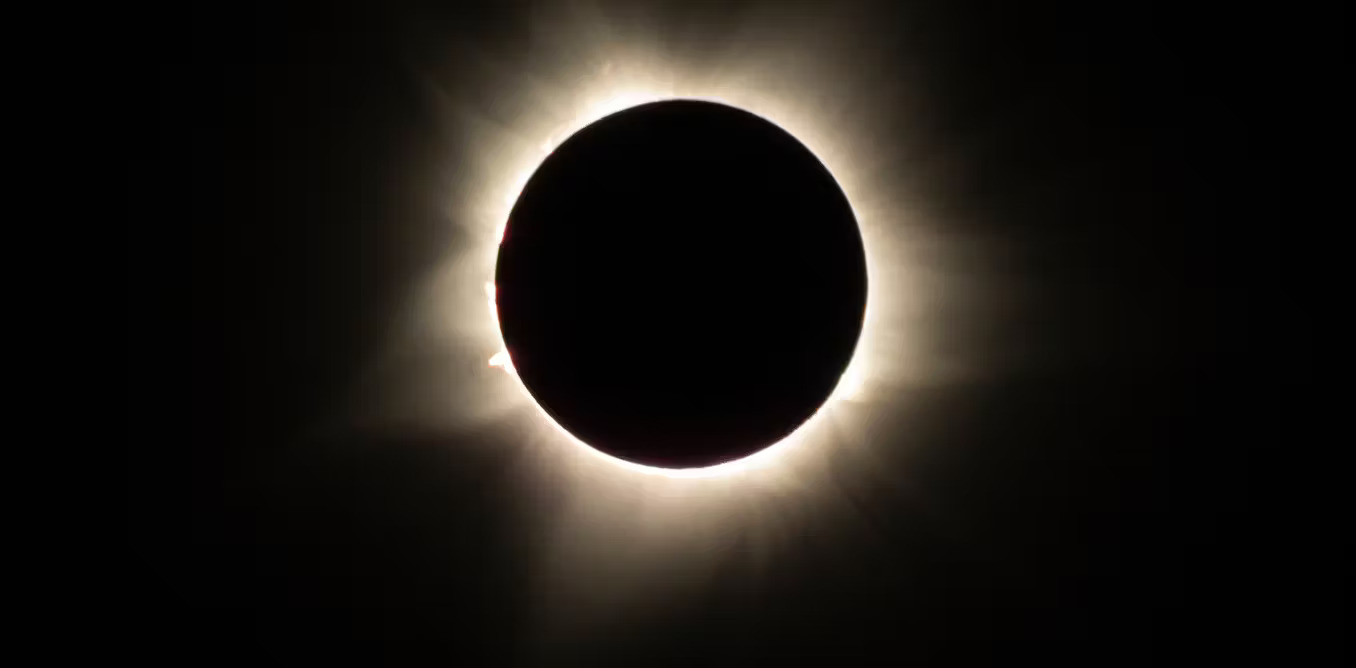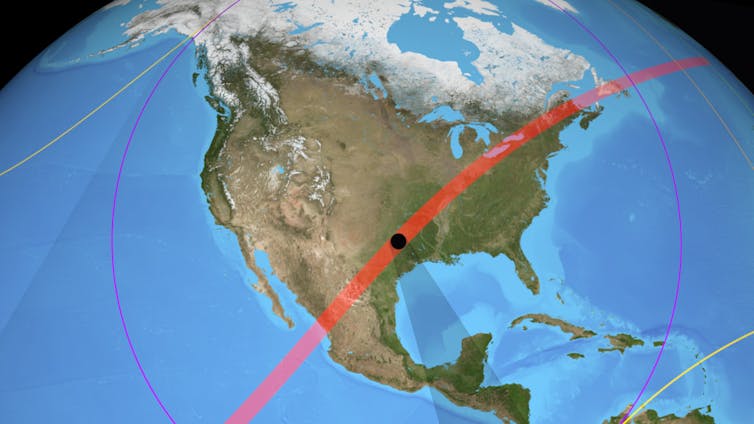Gallai’r clip llawn o’r haul yng Ngogledd America daflu goleuni ar bos parhaus am yr Haul

aeonWAVE / Shutterstock
28 Mawrth 2024
Mewn erthygl yn The Conversation, mae’r Athro Huw Morgan o'r Adran Ffiseg yn trafod y wyddoniaeth sydd i’w wneud yn ystod clipiau fel rhan o astudiaeth ar glip llawn o’r haul a fydd yn digwydd ar draws Gogledd America ar 8 Ebrill.
A total solar eclipse takes place on April 8 across North America. These events occur when the Moon passes between the Sun and Earth, completely blocking the Sun’s face. This plunges observers into a darkness similar to dawn or dusk.
During the upcoming eclipse, the path of totality, where observers experience the darkest part of the Moon’s shadow (the umbra), crosses Mexico, arcing north-east through Texas, the Midwest and briefly entering Canada before ending in Maine.
Total solar eclipses occur roughly every 18 months at some location on Earth. The last total solar eclipse that crossed the US took place on August 21 2017.
An international team of scientists, led by Aberystwyth University, will be conducting experiments from near Dallas, at a location in the path of totality. The team consists of PhD students and researchers from Aberystwyth University, Nasa Goddard Space Flight Center in Maryland, and Caltech (California Institute of Technology) in Pasadena.
There is valuable science to be done during eclipses that is comparable to or better than what we can achieve via space-based missions. Our experiments may also shed light on a longstanding puzzle about the outermost part of the Sun’s atmosphere – its corona.

The Sun’s intense light is blocked by the Moon during a total solar eclipse. This means that we can observe the Sun’s faint corona with incredible clarity, from distances very close to the Sun, out to several solar radii. One radius is the distance equivalent to half the Sun’s diameter, about 696,000km (432,000 miles).
Measuring the corona is extremely difficult without an eclipse. It requires a special telescope called a coronagraph that is designed to block out direct light from the Sun. This allows fainter light from the corona to be resolved. The clarity of eclipse measurements surpasses even coronagraphs based in space.
We can also observe the corona on a relatively small budget, compared to, for example, spacecraft missions. A persistent puzzle about the corona is the observation that it is much hotter than the photosphere (the visible surface of the Sun). As we move away from a hot object, the surrounding temperature should decrease, not increase. How the corona is heated to such high temperatures is one question we will investigate.

We have two main scientific instruments. The first of these is Cip (coronal imaging polarimeter). Cip is also the Welsh word for “glance”, or “quick look”. The instrument takes images of the Sun’s corona with a polariser.
The light we want to measure from the corona is highly polarised, which means it is made up of waves that vibrate in a single geometric plane. A polariser is a filter that lets light with a particular polarisation pass through it, while blocking light with other polarisations.
The Cip images will allow us to measure fundamental properties of the corona, such as its density. It will also shed light on phenomena such as the solar wind. This is a stream of sub-atomic particles in the form of plasma – superheated matter – flowing continuously outward from the Sun. Cip could help us identify sources in the Sun’s atmosphere for certain solar wind streams.
Direct measurements of the magnetic field in the Sun’s atmosphere are difficult. But the eclipse data should allow us to study its fine-scale structure and trace the field’s direction. We’ll be able to see how far magnetic structures called large “closed” magnetic loops extend from the Sun. This in turn will give us information about large-scale magnetic conditions in the corona.
The second instrument is Chils (coronal high-resolution line spectrometer). It collects high-resolution spectra, where light is separated into its component colours. Here, we are looking for a particular spectral signature of iron emitted from the corona.
It comprises three spectral lines, where light is emitted or absorbed in a narrow frequency range. These are each generated at a different range of temperatures (in the millions of degrees), so their relative brightness tells us about the coronal temperature in different regions.
Mapping the corona’s temperature informs advanced, computer-based models of its behaviour. These models must include mechanisms for how the coronal plasma is heated to such high temperatures. Such mechanisms might include the conversion of magnetic waves to thermal plasma energy, for example. If we show that some regions are hotter than others, this can be replicated in models.
This year’s eclipse also occurs during a time of heightened solar activity, so we could observe a coronal mass ejection (CME). These are huge clouds of magnetised plasma that are ejected from the Sun’s atmosphere into space. They can affect infrastructure near Earth, causing problems for vital satellites.
Many aspects of CMEs are poorly understood, including their early evolution near the Sun. Spectral information on CMEs will allow us to gain information on their thermodynamics, and their velocity and expansion near the Sun.
Our eclipse instruments have recently been proposed for a space mission called Moon-enabled solar occultation mission (Mesom). The plan is to orbit the Moon to gain more frequent and extended eclipse observations. It is being planned as a UK Space Agency mission involving several countries, but led by University College London, the University of Surrey and Aberystwyth University.
We will also have an advanced commercial 360-degree camera to collect video of the April 8 eclipse and the observing site. The video is valuable for public outreach events, where we highlight the work we do, and helps to generate public interest in our local star, the Sun.![]()
Mae'r erthygl hon wedi ei hailgyhoeddi o The Conversation dan drwydded Creative Commons. Darllenwch yr erthygl wreiddiol.



